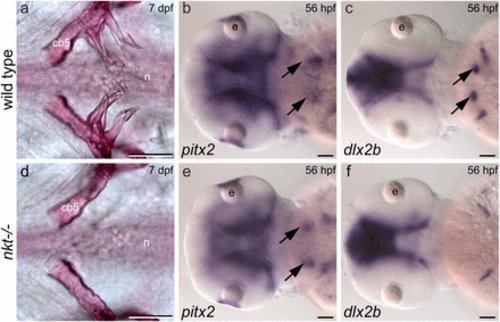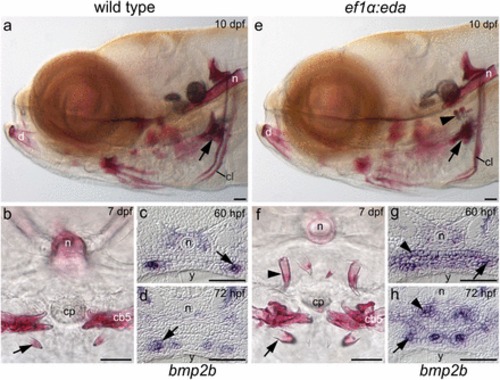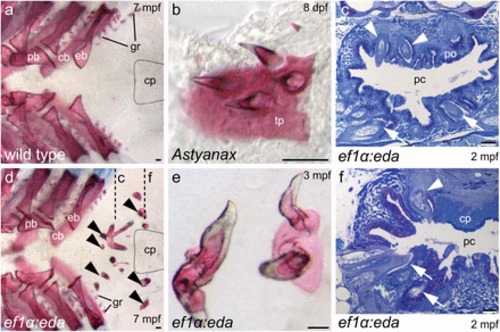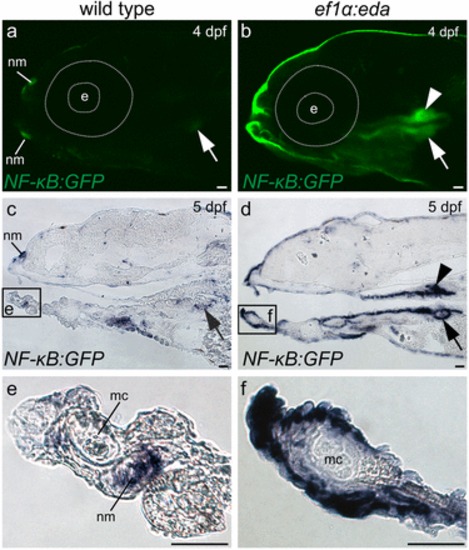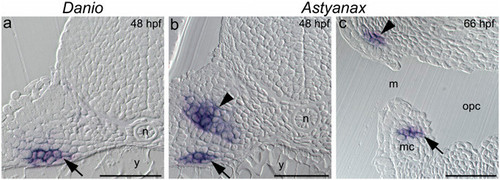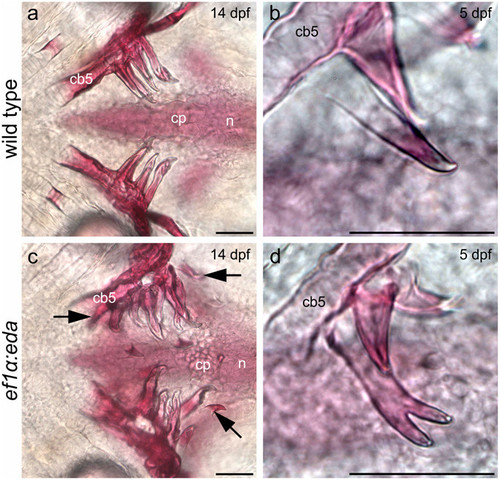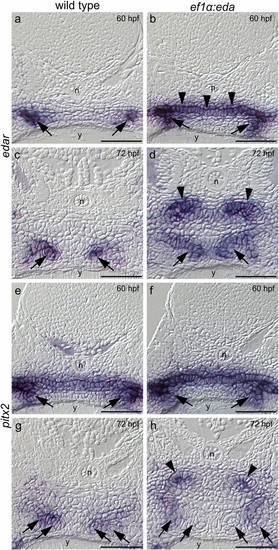- Title
-
Selection and constraint underlie irreversibility of tooth loss in cypriniform fishes
- Authors
- Aigler, S.R., Jandzik, D., Hatta, K., Uesugi, K., Stock, D.W.
- Source
- Full text @ Proc. Natl. Acad. Sci. USA
|
Regional loss of eda expression is associated with reduction of dentition in the zebrafish lineage. (A) Teeth were lost from the mouth and upper pharynx in the zebrafish (D. rerio) lineage after its divergence from that of the Mexican tetra (A. mexicanus). (B) eda expression in upper (arrowhead) and lower (arrow) jaws of Astyanax. (C and D) eda expression in upper (arrowhead) and lower (arrow) pharynx of Astyanax. (E) Absence of eda expression in the mouth of Danio. (F and G) eda expression in the lower (arrow) but not upper pharynx of Danio. All eda expression shown is in mesenchyme, as confirmed by sectioning (Fig. S1). Abbreviations: e, eye; hpf, hours postfertilization; lpt, lower pharyngeal teeth; m, mouth; ot, oral teeth; upt, upper pharyngeal teeth; y, yolk. (Scale bars, 50 μm.) EXPRESSION / LABELING:
|
|
The nkt mutation in eda results in early arrest of pharyngeal tooth development. (A and D) Ventral views of alizarin stained 7-dpf larvae showing complete absence of teeth in an nkt mutant homozygote. A single tooth is sometimes formed on one side of these mutants (n = 4 of 19). (B and E) pitx2 is expressed in presumptive pharyngeal tooth epithelium (arrows) in the nkt mutant homozygote (n = 5 of 5), heterozygote (n = 11 of 11), and wild-type homozygote (n = 5 of 5). (C and F) dlx2b is expressed in pharyngeal tooth germs (arrows) of wild-type homozygotes (n = 3 of 3) and nkt heterozygotes (n = 12 of 12), but its expression is lacking in the pharynx of the nkt mutant homozygote (n = 5 of 5). Abbreviations: cb5, fifth ceratobranchial bone; e, eye; hpf, hours postfertilization; n, notochord. (Scale bars, 50 μm.) |
|
Ectopic Eda expression restores upper pharyngeal teeth to the zebrafish. Lower pharyngeal teeth (arrows) in lateral (A) and transverse (B) views of wild-type alizarin red-stained larvae. (C and D) bmp2b expression is limited to tooth germs (arrows) of the lower pharynx in wild-type. Upper pharyngeal teeth (arrowheads) in lateral (E) and transverse (F) views of ef1α:eda transgenic zebrafish. (G) bmp2b expression is induced in the upper pharyngeal epithelium (arrowhead) by ectopic eda expression and becomes limited to tooth germs (arrowhead) at later stages (H). Abbreviations: cb5, fifth ceratobranchial; cl, cleithrum; cp, chewing pad; d, dentary bone; n, notochord; y, yolk. (Scale bars, 50 μm.) EXPRESSION / LABELING:
PHENOTYPE:
|
|
The upper of pharynx of adult zebrafish is only partially restored to the ancestral condition by ectopic eda expression. (A and D) Dorsal views of alizarin-stained pharyngeal arches with fifth ceratobranchials removed to show location of ectopic teeth (arrowheads in D) posterior to upper gill arch elements and dorsal to fifth ceratobranchials. Approximate position of the chewing pad is indicated by dotted lines. (E) Calcified tissue uniting ectopic teeth resembles upper pharyngeal toothplates of A. mexicanus (B). (C and F) Transverse sections (approximate plane of section indicated in D) reveal teeth in the vicinity of the palatal organ and projecting into the pharyngeal cavity (arrowheads in C) as well as lateral to the chewing pad (arrowhead in F). Lower pharyngeal teeth in (C and F) indicated by arrows. Abbreviations: cb, ceratobranchial; cp, chewing pad; eb, epibranchial; gr, gill raker; mpf, months postfertilization; pb, pharyngobranchial; pc, pharyngeal cavity; po, palatal organ; tp, toothplate. (Scale bars, 50 μm.) PHENOTYPE:
|
|
Competence to respond to Eda signaling is distributed throughout the oropharyngeal cavity. (A and B) Confocal imaging of GFP fluorescence and C-F) in situ hybridization analysis of gfp RNA expression in NF-κB reporter zebrafish. Oral expression is limited to neuromasts and pharyngeal expression to lower tooth germs (arrow) in fish lacking the ef1α:eda transgene (A, C, and E). Presence of this transgene (B, D, and F) induces reporter expression throughout the oropharyngeal cavity, including in lower (arrow) and upper (arrowhead) pharyngeal tooth germs. Abbreviations: dpf, days postfertilization; e, eye; mc, Meckel’s cartilage; nm, neuromast. (Scale bars, 50 μm.) |
|
Ectodysplasin (eda) is expressed in tooth-forming mesenchyme in the zebrafish and Astyanax mexicanus. (A) Transverse section showing expression of eda in lower pharyngeal mesenchyme (arrow) of the zebrafish. (B) Transverse section showing expression of eda in lower (arrow) and upper (arrowhead) pharyngeal mesenchyme of A. mexicanus. (C) Sagittal section showing expression of eda in mesenchyme of the lower (arrow) and upper (arrowhead) jaws of A. mexicanus. Abbreviations: hpf, hours postfertilization; m, mouth; mc, Meckel’s cartilage; n, notochord; opc, oro-pharyngeal cavity; y, yolk. (Scale bars, 50 μm.) EXPRESSION / LABELING:
|
|
Ectopic eda expression results in supernumerary and bicuspid teeth in the lower pharynx of the zebrafish. (A) Ventral view of the fifth ceratobranchial dentition of alizarin-stained wild-type zebrafish. (B) Unicuspid shape of wild type pharyngeal teeth. (C) Supernumerary teeth (arrows) in ef1;;alpha;:eda transgenic zebrafish. (D) Bicuspid tooth in ef1α:eda transgenic zebrafish. Abbreviations: cb5, fifth ceratobranchial bone; cp, chewing pad; dpf, days postfertilization; n, notochord. (Scale bars, 50 ;;mu;m.) PHENOTYPE:
|
|
Tooth rudiments are absent from the upper pharynx of wild-type zebrafish. Ectodysplasin A receptor (edar) expression is limited to tooth germs (arrows) of the lower pharynx in wild-type (A and C) but is induced in upper pharyngeal epithelium (arrowheads) and upper pharyngeal tooth germs (arrowheads) of the ef1α:eda transgenic (B and D). Expression of the transcription factor pitx2 is found in lower pharyngeal tooth germs (arrows) and upper pharyngeal epithelium (arrowheads) at 60 hpf in the wild-type (E) and ef1α:eda transgenic (F). Expression of this gene becomes restricted to lower pharyngeal tooth germs (arrows) at 72 hpf in the wild-type (G), but is also expressed in upper pharyngeal tooth germs (arrowheads) in the ef1α:eda transgenic (H). Abbreviations: hpf, hours postfertilization; n, notochord; y, yolk. (Scale bars, 50 μm.) |
|
Tooth development is not induced in the mouth of ef1α:eda transgenic zebrafish. Comparison of gene expression in ventral views of the lower jaw of wild-type zebrafish (A, D, G, J, M, P), ef1α:eda transgenbic zebrafish (B, E, H, K, N, Q), and wild-type A. mexicanus (C, F, I, L, O, R). Arrowheads indicate location of tooth germs in A. mexicanus. (A–C) pitx2 is expressed in oral epithelium of A. mexicanus, with higher levels present in tooth germs (1). No expression corresponding to tooth germs is seen in wild type or ef1α:eda transgenic zebrafish, although oral expression is present. (D–F) Sonic hedgehog (shh) is expressed in oral epithelium of A. mexicanus, with higher levels present in tooth germs (1). No expression corresponding to tooth germs is seen in wild type or ef1α:eda transgenic zebrafish, although oral expression is present. (G–I) Bone morphogenetic protein 2b (bmp2b) is expressed in tooth germs of A. mexicanus (2). No expression corresponding to tooth germs is seen in wild-type or ef1α:eda transgenic zebrafish, although oral mesenchymal expression (2) is present. (J–L) The transcription factor dlx2b is expressed in tooth germs of A. mexicanus (1). No oral expression is seen in wild-type or ef1α:eda transgenic zebrafish. (M–O) Fibroblast growth factor 4 (fgf4) is expressed in tooth germs of A. mexicanus. No oral expression is seen in wild type or ef1α:eda transgenic zebrafish. (P–R) bmp2a is expressed in tooth germ mesenchyme in A. mexicanus (2). No oral expression is seen in wild-type or ef1α:eda transgenic zebrafish. Abbreviations: ch, ceratohyal; dpf, days postfertilization; mc, Meckel’s cartilage. (Scale bars, 50 &mu&m.) |
|
Ectodysplasin A receptor (edar) and EDAR-associated death domain (edaradd) are expressed in the mouth of the zebrafish and A. mexicanus. Ventral views reveal similar expression between the zebrafish (A and B) and A. mexicanus (C and D). Abbreviations: hpf, hours postfertilization; m, mouth. (Scale bars, 50 μm.) EXPRESSION / LABELING:
|


